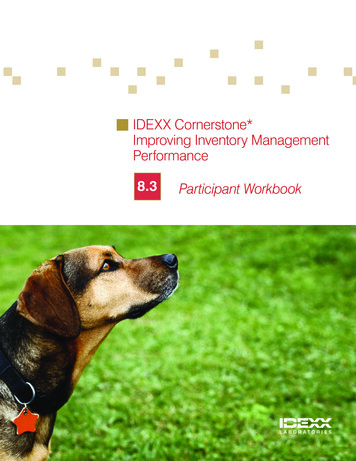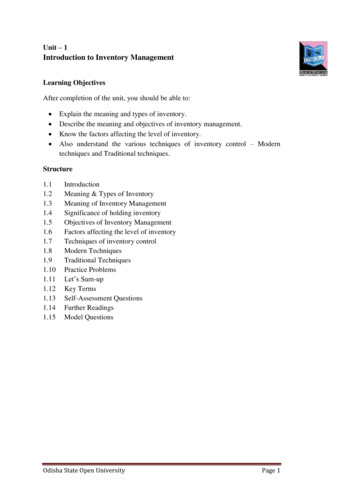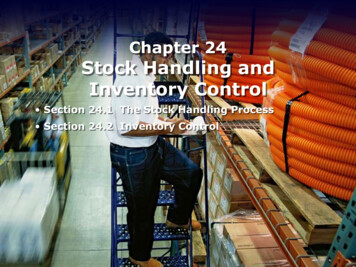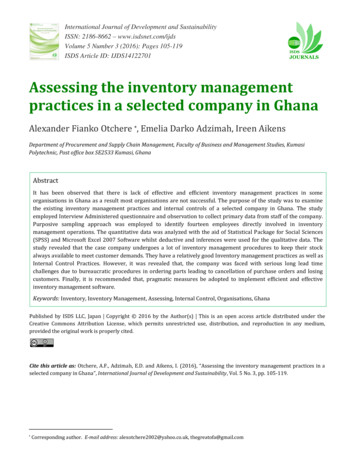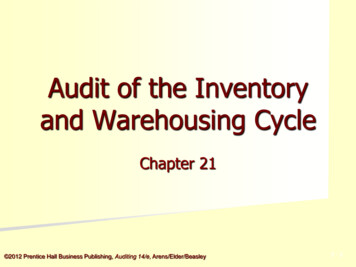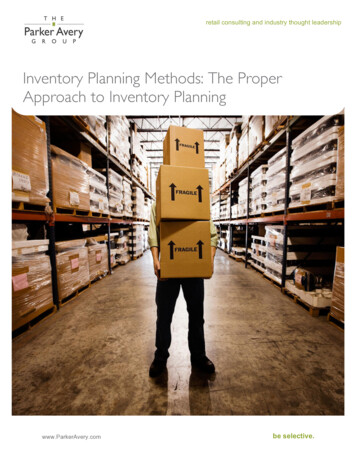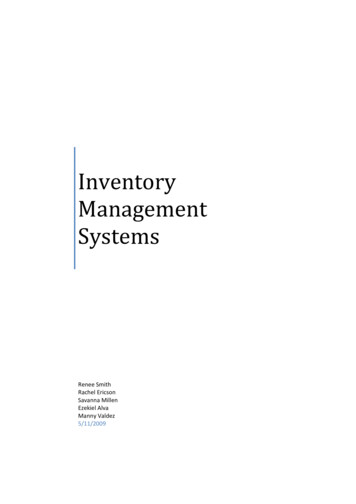
Transcription
InventoryManagementSystemsRenee SmithRachel EricsonSavanna MillenEzekiel AlvaManny Valdez5/11/2009
IntroductionInventory Management Systems is a key instrument for businesses whentracking their inventory. Typically, Inventory Management Systems are used byfirms that either sell a product or manufacture a product for purposes ofaccounting for all the tangible goods that allow for a sale of a finished product, orparts for making a product. The size and volume of a firm help dictate whether ornot a firm is in need of such a system as they can be quite extensive and costly.Large firms that have thousands of components must have a system in place forthe primary objective of tracking their assets. There are three main reasons whyan Inventory Management System is needed such as timing/lead time,forecasting, and utilizing economies of scale.The Inventory Management System is no different from any otherinformation system in that there are factors that make it successful. The basis forthis report is premised on the five components as outlined in our book. These fivecritical components are hardware, software, data, procedures and people. Asthese factors are discussed throughout the next several sections it becomes
evident that they are contingent upon one another, and frankly will not functionefficiently without the other.HardwareHardware is defined as, “the mechanical equipment necessary forconducting an activity, usually distinguished from the theory and design thatmake the activity possible.” Computer hardware includes all physical equipmentthat enables computers to function that consist of the mechanical, magnetic,electronic, and electrical devices comprising a computer system, as the CPU,disk drives, keyboard, or screen.Online inventory management systems require additional hardwarecomponents than just a basic computer. First, and most importantly, a mainserver that houses a database is required to store the data so that informationcan be provided universally to all the work systems. The information can beaccessed and changed by an individual, and then the updated information will bereflected in the main database for everyone to see. Individual work stations arealso a necessary hardware component of inventory management systems. Workstations include computers that are compatible with the inventory managementsoftware, and they connect to the main server to access the database.Employees input data into their workstations to update the main database. Also
employees, if allowed, can access information from the main database from theirworkstation. This can be a useful tool to quickly check inventory levels to assistwith customer service inquiries.In addition to the necessary hardware components, there are manyadditional hardware pieces that can be used to help with the efficiency of thesystem. For example, a bar code scanner can be used to scan in/out inventoryand then the transaction will immediately reflected in the system. While thishardware accessory is not required, it is much more efficient then updating theinventory levels manually. Bar code scanners can also be incorporated into aPersonal Data Assistant, also known as a PDA. A PDA is a useful portable,hardware tool that is a handheld computer device. The system can incorporate aPDA as a smaller workstation because it can access information from thedatabase, and add information to the database. A PDA with a bar code scanneris a convenient tool because when inventory is scanned, data can be directlyinputted into the system while on the go. The PDA barcode scanner can beuseful for a large store’s employee to carry with them. They could checkinventory levels for customers, and get product information without having to sitat an anchored workstation.SoftwareA main part in implementing an Inventory Management System is thecomponent of software. Software is the instruction for hardware that is on thecomputer side of the five-component framework of developing and using aninformation system. The system usually runs on a remote server and then the
data is delivered to clients via the internet. A software solution has a flexiblescalability so as the business grows, so can the inventory control solution.Today, there are many different types of software solutions that areavailable to assist in managing inventory within a firm. Before being able to utilizea system efficiently there are many factors that need careful consideration. Thegoal for the firm should be mapped out by both management and employees sothat everyone understands the results they are hoping to get with the inventorycontrol solution. There are a few ways to go about implementing the system.First, realize that the reason the firm needs to implement a new system isto help the people in the business achieve their goals and objectives. Althoughthe software solutions will be able to run substantial amounts of data throughdifferent reports and analyses, the firm must understand what exactly thesoftware solution will need to do for them to help the business grow and besuccessful. If the business does not realize the need for inventory managementand fail to recognize that using a software program will help them keep track oftheir numbers and forecast production, then it will be of little use to them overall.Second, after mapping and thinking about how the software solutionshould organize the data, there should be a large amount of investigation of allthe various inventory control systems that are available. Many companies offerdemos to the business to help them try it and see if it will fulfill their inventorycontrol needs. The demos will show them all the different reports that can bedone, as well as, get the users familiar with the technology and see if it issomething that they feel everyone could understand and use. There are different
costs associated with every different software company. The most commonpricing is per user that will be needed. Some software solutions offer a flat pricefor unlimited users, and other charge a specific price depending upon how manyusers there will be.Third, sometimes it is necessary for the firm to contact and hire aninventory control software specialist to help integrate the system and data oncethe software is chosen. If management does not feel comfortable with training theemployees and/or there are not enough resources to properly train all theemployees on how to use the inventory control software, it is in the firms bestinterest to spend a little more to help implement the system properly. There are anumber of reasons for this decision, and the main reason should be that because
the employees are the most important component. It is mandatory for the firm tobe confident that their employees will be able to use the system. If theiremployees and users do not know how to use the system, then the cost of thesystem and the implementation will be of no value to the firm. If they have thisgreat inventory control solution but no one knows how to run reports or use it tomanage the inventory levels, then it would be cheaper and just as good for thefirm to have not implemented to system in the first place.Furthermore, it is absolutely necessary to make sure that all employeeshave the proper training and knowledge of the system and all the aspects of howto successfully utilize all the features. Once the employees are confident with thesoftware, this will help the business benefit and should help them reach all theirgoals and objectives. Technology and trends are constantly changing in today’smarket, and for this reason there are continuously new and improved systemsavailable to firms. It is the firm’s responsibility to stay in touch with the everchanging technologies to make sure they are benefiting the most from thesoftware they have in place. A few different options that are available on themarket today are: Oracle, Fish Bowl Inventory, SmartTurn, and Interprise SuiteSolutions.DataData obtained through an Inventory Management System is truly valuableinformation. Data for this type of system provides several benefits for thecompany, and its vendors. In the business world, it is extremely important toensure that a company is cognizant of inventory so that opportunities are not
missed for sales. Regardless of what type of information a person or business istrying to compile, it can be quit cumbersome. It is equally as important to knowhow to utilize the data so that a company can be better off.Knowledge of current inventory levels is instrumental to a company beingable to compete in the market. If the demand for their product is more than thesupply, they are losing out on additional sales, and potentially losing futurebusiness from those customers, which affect the survival of some companies. Onthe other hand, if supply is greater than demand, a company will be sitting on toomuch inventory which leads to spoilage of products, outdated goods, and ties upcapital or increases exposure in terms of credit/loan payments. InventoryManagement Systems assist businesses with the checks and balances of theirstock in that it assures the entity that every item is identified, and accounted for inthe accounting department. The real big companies have actual full-timeemployees that manage this data full-time it is that important.Beyond the recording of current inventory levels, the InventoryManagement System helps with other areas such as monitoring trends. Aspreviously mentioned, it is important for a business to have an accurate amountof stock in hand to get the best of both worlds in not running out of supply andnot having too much on hand. The ability to track trends is an intangible assetbecause businesses can study what customers like, and what they don’t like. Arethere more sales on the weekend as opposed to the week? Does a company’sproduct cater to men, women, young adults, and adults? We see that anInventory Management System extends outside of just inventory levels. It can
help in identifying certain trends so that a company can work with theiroperations management, and marketing management to tailor specifically to theircustomers’ desires.Reviewing these trends, habits, and patterns will allow companies toforecast their inventory. Forecasting inventory is predicating what the demand ofthe product is going to be in the future, and this is extremely difficult to do sinceno one really has that crystal ball. However, this will allow a company and itsvendors to make sure that they are maximizing their sales opportunities,allocating their capital and resources appropriately, and many other aspects oftheir business. This information is just as important to their vendors as it is them.It was interesting to see that many of the businesses that we visited withutilized a very elementary tracking and monitoring system for their inventory. The
businesses that did were of course the larger companies, and they utilized hightech Inventory Management System programs. The procedures will be discussedlater, but it was interesting that most of the small, medium, and even twocompanies based their forecasting on the year priors performance. Some wouldutilize excel to track inventory, others would use access, but only a few wouldrely on an actual program to predict inventory needs based on criteria such aspast performance, determining peak times, and what products are more popularin certain areas.Crest Beverage, an alcohol distributer, is able to forecast what productsales best in particular areas of San Diego County, and in what stores. This willallow them to utilize this sales tool so that they can provide this data to the storepurchasing their product in an attempt obtain addition shelf space. Best Buy andWireless Superstore are in an industry where products change constantly. Whilethey may attempt to predict accurately, it is difficult in that they do not know howcustomers will respond to new products. They do not want to get caught in asituation where they have millions of dollars in an inventory that is no longer indemand, and they cannot offload that product.ProceduresInventory management is different at every company. It doesn’t matter thesize of the company or the industry the company is in they will all have differentprocedures to follow for every step of inventory management. When talking aboutthe five-component framework procedures are defined as: the procedures thatthe four other components use. So this refers to the procedures for the hardware,
software, data, and people. Procedures is on the human side of the diagram andit is categorized under instructions. When discussing inventory management ourteam found that every place has their own procedures for these components andit mainly depends on the management.We went to many different companies in many different industries. Someof the companies that have not been mentioned are Gap, Trader Joe’s,Giovanni’s, Original Roadhouse Grill, Bill’s Country Kitchen, and Bing Crosby’s.We asked the same questions to these places concerning their procedures withinventory management. Some of the questions that were about procedureswould be: What type of inventory system does your company use? How doesyour company project future inventory? How many people does it take to doinventory? How many hours does it take to do inventory? Do vendors help? Werecorded the companies’ answers to these questions and compared them to
other companies. We noticed a wide range of different procedures when it comesto inventory control.The different procedures can vary in many ways depending on theproducts, the size, and the management choices of the company. Some of thevariables in inventory management would be: frequency, workers, labor hours,teams, vendor involvement, and outside inventory consultants. Frequency wouldbe how often an inventory count is being conducted. Workers refers to how manyworkers does it take to do an inventory count, and how many labo
Inventory Management Systems is a key instrument for businesses when tracking their inventory. Typically, Inventory Management Systems are used by firms that either sell a product or manufacture a product for purposes of accounting for all the tangible goods that allow for a sale of a finished product, or parts for making a product. The size and volume of a firm help dictate whether orFile Size: 835KBPage Count: 20


